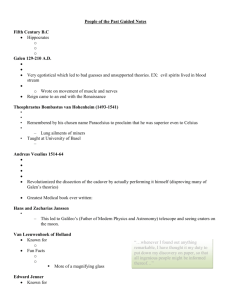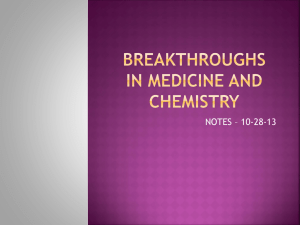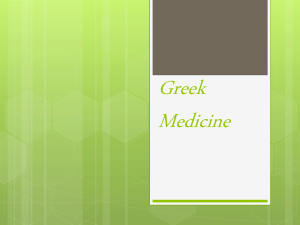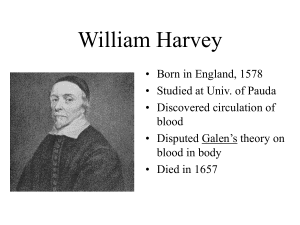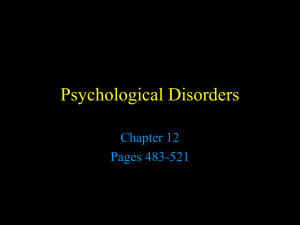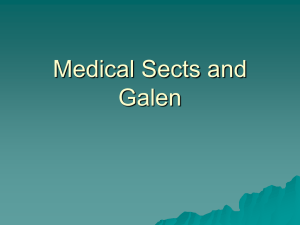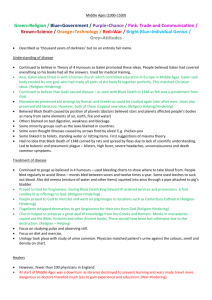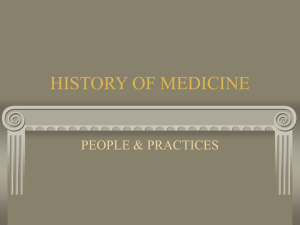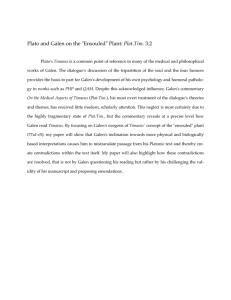File - Mind Body Science
advertisement
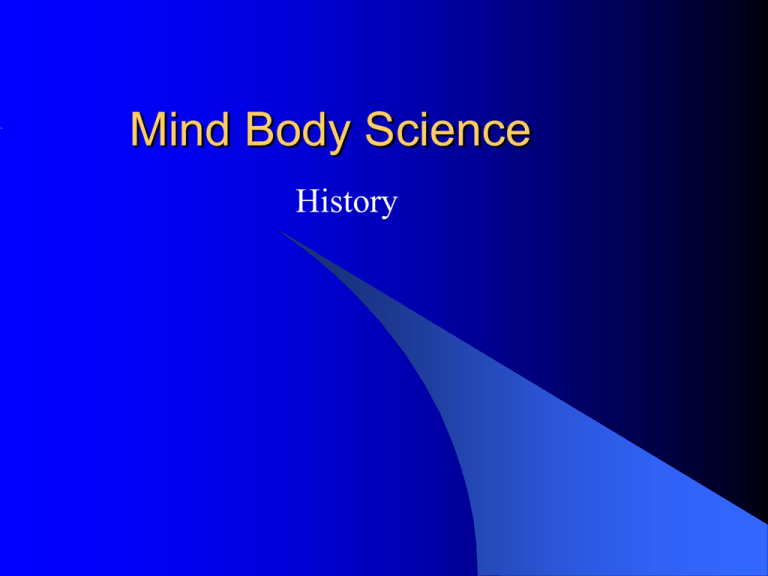
Mind Body Science History Introduction You will learn: – The earliest medicine assumed a connection between body/mind/spirit. – A shift began to occur in the 17th century, as science and technology developed – Growing understanding of the world changed our conception of disease – Beginning in the early 19th century, and continuing to this day, we see a return to the acceptance of a body/mind connection. In The Beginning: Making Sense of the World Power of the ancestors Power of natural forces Power of gods and demons Power of prayer and belief Three sources of mind-body healing for millennia Belief and Expectation – Living in harmony with nature – Using natural substances to cure Natural course of Recovery – Acceptance of death as part of life Spiritual practices Beginning understanding of natural causes of disease Hippoc rates 460BC -370 BC Yin Yang and 5 phase theory: 200s BC Galen 129217 AD Hippocrates Teachings came about in opposition to the supernaturally based practices of the time Beginning of medicine as we know it: divorced from superstition and necromancy based on observation: rational, empirical Ethical: physician’s obligation is to the patient Hippocratic principles Disease seen in context of patient’s life Treatment was to restore the natural conditions and defenses of the sick person and reestablish his proper relationship to surroundings. Diseases categorized by major symptoms (confusing causes) Seeds of holistic medicine Aphorisms of Hippocrates “Life is short, The Art is long, opportunity is fleeting, experiences delusive, judgment difficult.” Sickness develops when equilibrium is disturbed: it is the doctor’s role to restore it Equilibrium of the 4 humors Blood (originating in the heart) Yellow bile (liver) Black bile (spleen) Phlegm (brain) Related to the 4 elements: fire, air, earth and water, and the 4 qualities of hot, dry, cold and wet THE FOUR HUMORAL TYPES OF COUPLES (1470 MS) SANGUINE PLEGMATIC MELANCHOLIC CHOLERIC Hippocratic physicians sought the cause of disease: Understanding the 4 humors, seasons, etc. Patient’s constitution - state of the humors in her body (sanguine, melancholic, bilious, phlegmatic) Observed changes in facial expression, color, temperature, breathing, body position, nails, hair, abdominal contour, tasted blood and urine, smelled stool, etc Fundamental change in medicine: Based on observable phenomenon “To help, or at least, do no harm” Nature has a curative power Natural inclination of the organism is to reestablish equilibrium “Most things get better by themselves…most things, in fact are better by morning.” (Lewis Thomas) Galen - 2nd century AD – Extracted the best from many competing systems, and led medicine back to direct observation – His research into anatomy and physiology led to a new understanding of the body and how it gets sick Galen’s system based on dissections in anatomy (nonhuman), experiments in physiology and clinical observation of patients. – However, he was a man of his time, and allowed his beliefs to supersede his observations Galen’s legacy Concepts of sickness and its treatment influenced medicine for centuries - well into the 1600’s His herbal remedies were being used well into the 20th century The Renaissance Cadaver dissections began to be used in medical training Vivisections of small animals were used to understand organ function Galenic errors uncovered, to great consternation De Humani Corporis Fabrica Libra Septem Produced by Andreas Vesalius in 1543 Organized in 7 books: bones, muscles, blood vessels, nerves, abdominal and reproductive organs Represented a revolution in scientific approach Vesalius’ Legacy: Overturned century’s of blind adherence to Galenic theory and practice One of the most influential physicians in the history of medicine Was vilified in his lifetime The Beginnings of Separation of Body and Mind Rene Descartes 17th century: the body as machine The mind cannot directly improve body health The increasing “reductionist” view of Western medicine “I think, therefor I am” Identity was equated with rational mind Led to view of universe as mechanical system consisting of separate objects Body’s innate “knowing” became less important The Next Step in the Development of Medical Science: Morgagni Spent his life writing the Seats and Causes of Disease… 700 case histories The death knell of humoral theory Now had to look at “the cries of the suffering organs” Father of pathological anatomy Giovanni Morgagni cont’d Father of physical exam The goal for drs became to predict autopsy findings before death All teaching hospitals now have the CPC: clinical pathological correlation…coming up with the diagnosis based on the s & s. This was the Age of Enlightenment questioning age-old paradigms What are the positive aspects of the “Cartesian” world view? Rudolf Virchow - 1850s Still did not have any effective therapy to treat disease: could describe organ and tissue, but not where disease begins Microscope became key Writes “Cellular Pathology” - read by everyone Abnormality of cellular function: pathophysiology Virchow, cont’d All diseases start within the cells All cells come from the fertilized egg Showed that cancer cells had once been normal to which something had happened In a single stroke, ended the idea of miasmas Father of public health The “Miraculous” Modern Medical Machine Louis Pasteur: Germ theory of disease1850s Joseph Lister: development of antiseptic procedures Robert Koch: identified specific organisms responsible for specific diseases - 1880s Success of antibiotics was profound Whole hospitals were emptied with the discovery of penicillin Saved thousands of lives of WW II wounded Surgery and Drugs Became the Treatments of Choice Tendency to misuse and overuse successful drugs (antibiotics being used on viruses), and to overemphasize the power of surgery Placebo becomes a bad word Unethical to give an inert substance to a patient with the promise that “this will make you feel better” The placebo effect in double-blind controlled studies was dismissed as “all in the mind” The Return to Ancient Roots Oliver Wendell Holmes - 19th century mind can affect body and good bedside manner William James: further observations of mind body connections Walter Bradford Cannon: the ID of the fight or flight response; revived the concept of homeostasis It’s True! Body and Mind are Related Freud and Psychoanalysis 1929 Progressive Relaxation Autogenic training Acceptance of ‘psychosomatic illnesses” Research into the physiologic effects of stress Medical Breakthroughs since the 1960s Identification of the relaxation response Expanded understanding of the placebo effect Linking of mind body treatments to an increasing number of health conditions Studies now showing that mind body approaches can actually alter genetic expression and bolster health The Present Research has legitimized the mind-body connection Government funding available Leading hospitals and medical schools have instituted Mind-Body Programs “Integrative Medicine” “Complementary And Alternative Medicine” are accepted Therapies include: Yoga Meditation Mindfulness practices Nutrition Hypnosis Positive thinking, visualization Self-expression: art, dance, sound Additional Therapies Acupuncture Bio-feedback Exercise Massage Alexander Technique Feldenkrais Rolfing Summary Ancient wisdom held body, mind and spirit as one Separation began in the 17th century Ancient wisdom returns, blessed by the medical establishment Increased understanding of the physiological changes of stress and relaxation This is the language that is now used by business, sports, the arts, all of your future clients: you need to know how to speak the language of body mind science. “Where there is love of human kind, there is also love of the art of medicine.” Hippocrates We shall not cease from exploration, and the result of all our exploring will be to arrive where we started, and know the place for the first time. TS Eliot QuickTime™ and a decompressor are needed to see this picture.

